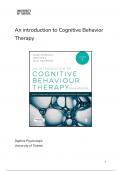An introduction to Cognitive Behavior
Therapy
Daphne Psychologie
University of Twente
1
,Inhoudsopgave
Chapter 1: Basic theory, development and current status of CBT
Chapter 3: The therapeutic relationship
Chapter 7: Socratic Methods
Chapter 12: Depression
Chapter 13: Anxiety disorders
Chapter 14: Anxiety disorders: Specific models and treatment protocols
Chapter 15: Wider applications of CBT
2
,Chapter 1: Basic theory, development and current
status of CBT
Introduction
CBT is being criticized by being too simple. Therefore, this book focuses on understanding
the therapy, instead of providing a guide on how to use it. Also, CBT is not a single method,
but a movement. This book is based on the Beckian model from Beck, as this is the most
prominent one in the UK.
A brief history of CBT
Modern CBT is influenced by two influences:
1. Behavior therapy (Wolpe and others) - this movement arose against the
psychodynamic paradigm by Freud. This movement lacked empirical evidence,
because what went on in a person’s mind is not directly observable, and therefore
not amenable to study. Because of this, behaviorists started observing associations
between stimuli and responses, also known as the learning theory. After that,
procedures were created that focused on learning a new, more helpful, association.
For example, when someone was scared of horses, a new non-fearful association
had to be learned. This treatment is called systematic desensitization, whereby
clients had to imagine the feared stimulus whilst practicing relaxation. Later on, this
type of imaginal exposure was replaced by in vivo exposure.
The pro’s of this approach were:
a. Taking an empirical approach to provide evidence of the effectiveness.
b. It was a more economical treatment, because less sessions were needed
compared to psychodynamic treatment.
The cons of this approach were:
a. Mental processes were neglected.
2. Cognitive therapy (Beck) and the cognitive revolution - The cognition revolution
started because we wanted to search for ways to include cognitive components in
psychology again. Beck started with writing a book on CT for depression and found
that CT was as effective for treating depression as medication. From this point, BT
and CT blended together into ‘cognitive behavior therapy’.
Some basic principles
1. Cognitive principle - Tells that emotional reactions and behavior are influenced by
cognitions (thoughts, mental images and beliefs). This becomes clear when you
start seeing that people react differently to similar events. So, the event does not
completely determine emotion, but cognition does. In other words, the
3
, interpretations people make of the event determines the way people feel and
behave. And different cognitions give rise to different emotions. Cognitions about
uncertainty cause emotions characterized by fear or shame. This way, we can help
people by changing the way they think about certain events.
2. Behavioral principle - Tells that emotions and cognitions influence your behavior,
which influences your emotions and cognitions afterwards. This way, changing what
you do is a powerful way of changing thoughts and emotions.
3. Continuum principle - Tells that mental health problems arise from extreme
versions of normal processes. So, pathological states are basically the same as
normal states, but somewhat exaggerated. Both kinds of states are thus on the
same continuum. Mental health problems can happen to anyone.
4. The here-and-now principle - In contrast with the psychodynamic approach, CBT
sees current processes as the main target of treatment. Psychoanalysis argued that
this would lead to symptom substitution: when you don’t treat the unconscious,
unobservable symptoms, the client develops new symptoms. But research shows
that this is rare, and that tackling symptoms directly results in a more global
improvement. Right now, what is happening in the present is our main concern in
CBT. Not the processes that caused the problem.
5. Interacting system principle - Tells that there are four internal systems that
influence mental problems:
a. Cognition
b. Affect or emotion
c. Behavior
d. Physiology
These interact with each other in complex feedback processes and with the
environment. This is illustrated in the Five-system framework by Padesky and
Mooney. Sometimes, the states are not correlated, like when someone shows
courage (someone can do something despite one feeling fearful).
6. The empirical principle - Tells that we should always use scientific evidence,
because:
a. CBT has made advances into new areas through the use of science.
b. We have confidence in telling people that it is effective.
c. It saves money if we know something works.
7. The interpersonal principle - Tells that the working alliance between clients and
therapists is really important, because therapists monitor their own emotions and
cognitions to clients. In CBT, we work with an informed and active person and we
consider and formulate dynamic aspects of our relationship.
Levels of cognition
4






